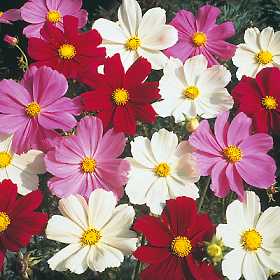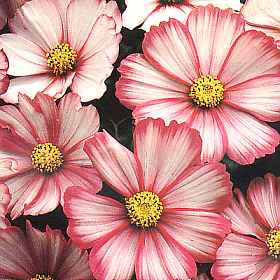|
Cosmos
 Cosmos originated in
Mexico. The priests who cultivated it in Mexico gave it the greek name
cosmos, because they thought it perfectly described the harmony and the perfect symmetry of its flower
petals. Cosmos originated in
Mexico. The priests who cultivated it in Mexico gave it the greek name
cosmos, because they thought it perfectly described the harmony and the perfect symmetry of its flower
petals.
There are approximately 20 different varieties of this plant. Their basic difference is in the appearance of the leaves but their flowers are more or less the
same, their colors ranging from white until dark red.
Cosmos can be grown in poor soils and needs plenty of sun, ideally 8 hours of sunlight a
day. Water only when the plant looks thirsty and its leaves start to droop and make sure the pot or the soil has very good drainage to avoid root
rot. Cosmos does not need fertilizing at any stage.
Its great advantages are, beyond its obvious beauty, the ease of growing
them, very resistant to pests and disease, ideal for use in warm and dry climates like
ours, suitable for poor soils, self-seeding in the garden. Moreover, its flowers are so beautiful and they can easily be made into dried bouquets to add summer color in the middle of the
winter. They also attract butterflies and are suitable for use in flower beds and pathways in the garden or to create a beautiful contrast planted among evergreen
shrubs.
Care
 Plant the seeds in
spring, when the weather starts to warm up. The seeds are slow to
germinate, they need 7-21 days, depending on the variety and the
conditions. Transplant the seedlings when they reach the 4-leaves
stage. Alternatively, you can seed directly in the garden when you are certain that the temperature will not drop below 15oC. If sown
outdoors, there is no need to thin out the seedlings. Keep in mind that cosmos
self-seeds in the garden, so the number of your plants will increase during the
summer. Plant the seeds in
spring, when the weather starts to warm up. The seeds are slow to
germinate, they need 7-21 days, depending on the variety and the
conditions. Transplant the seedlings when they reach the 4-leaves
stage. Alternatively, you can seed directly in the garden when you are certain that the temperature will not drop below 15oC. If sown
outdoors, there is no need to thin out the seedlings. Keep in mind that cosmos
self-seeds in the garden, so the number of your plants will increase during the
summer.
Also, take into account that you will need approximately 50 days from germination for the plant to produce
flowers, so plan ahead.
When the seeds start to form, gather them and prune the plant to help it freshen up and to enhance flower
production. Cosmos will bloom all summer and will die back when the temperature drops below 15oC. Store the seeds in a dry and cool location to use next
spring.
|
